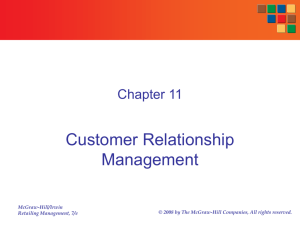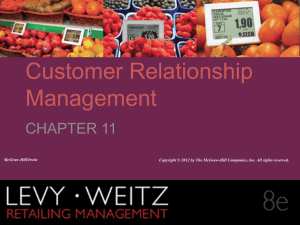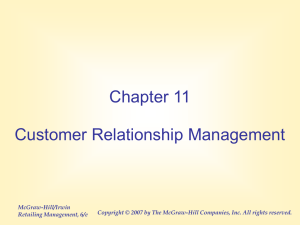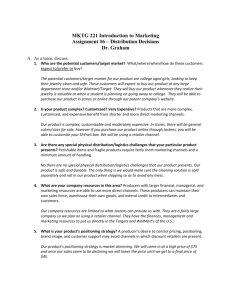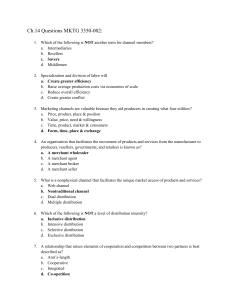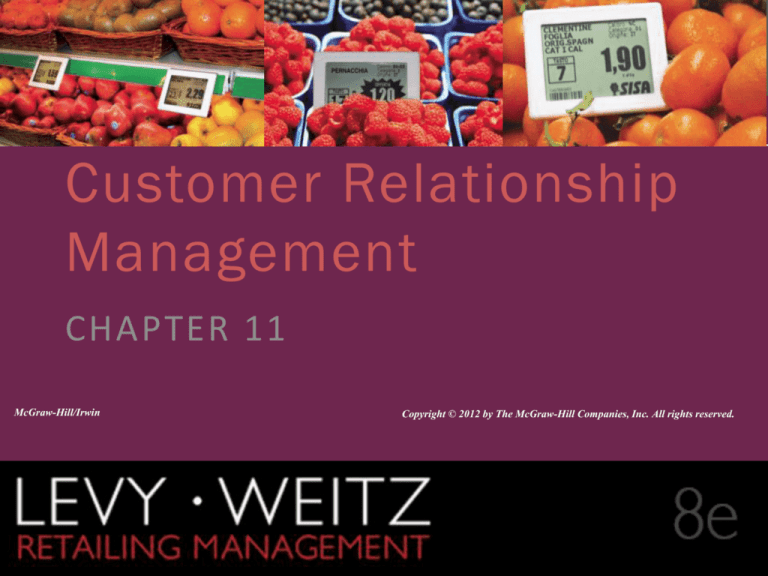
CCHHAAPPTTEERR 11
21
Customer Relationship
Management
CHAPTER 11
McGraw-Hill/Irwin
Retailing Management 8e
Copyright © 2012 by The McGraw-Hill Companies, Inc. All rights reserved.
© The McGraw-Hill Companies, All rights reserved.
11 - 1
Retailing Strategy
CCHHAAPPTTEERR 11
21
Retail Market Strategy
Financial Strategy
Retail Locations
Retail Site Location
Human Resource Management
Information Systems and Supply Chain Management
Customer Relationship Management
11 - 2
Questions
•
•
•
•
•
•
•
CCHHAAPPTTEERR 11
21
What is customer relationship management?
Why do retailers want to treat customers differently?
What is customer lifetime value?
How do retailers determine who their best customers are?
How can retailers build customer loyalty?
What can retailers do to increase their share of wallet?
What can retailers do to alleviate the privacy concerns of
their customers?
11 - 3
Customer Relationship Management
(CRM)
CCHHAAPPTTEERR 11
21
• A business philosophy and set of strategies, programs,
and systems that focus on identifying and building
loyalty with a retailer’s most valuable customers.
11 - 4
CRM
CCHHAAPPTTEERR 11
21
• All customers are not equally profitable, and more or
less profitable customers need to be treated differently
• Retailers now concentrate on providing more value to
their best customers using targeted promotions and
services to increase their share of wallet – the
percentage of the customers’ purchases made from the
retailer
11 - 5
Customer Loyalty
CCHHAAPPTTEERR 11
21
• Committed to purchasing merchandise and services
from a retailer
• Resist efforts of competitors to attract the loyal
customer
• Emotional attachment to retailer
• Personal attention
• Memorable positive experiences
• Brand building communications programs
11 - 6
Can Offering Price Discounts Achieve
Customer Loyalty?
CCHHAAPPTTEERR 11
21
No!
Retail strategies like these
can be copied by
competitors
These strategies encourage
customers to be always
looking for the best deal
rather than developing a
relationship with a retailer
McGraw-Hill Companies, Inc./Gary He, photographer
11 - 7
The CRM Process
CCHHAAPPTTEERR 11
21
CRM is an iterative process that turns customer data into
customer loyalty through four activities:
1. Collecting customer data
2. Analyzing the customer data and identifying target
customers
3. Developing CRM programs
4. Implementing CRM programs
11 - 8
CRM Process Cycle
CCHHAAPPTTEERR 11
21
11 - 9
Collecting Customer Data:
Customer Database
CCHHAAPPTTEERR 11
21
• Transactions – a complete history of purchases
• Purchase date, price paid, SKUs bought, whether or not the
purchase was stimulated by a promotion
• Customer contacts by retailer (touch points) --visits to
web site, inquires to call center, direct mail sent to
customer
• Customer preferences
• Descriptive information about customer
• Demographic and psychographic data
• Customer’s responses to marketing activities
11 - 10
Collecting Customer Data:
Identifying Information
CCHHAAPPTTEERR 11
21
Approaches that store-based retailers use:
• Asking for identifying information
• Telephone number, name and address
• Offering frequent shopper cards
• Loyalty programs that identify and provide rewards to
customers who patronize a retailer
• Private label credit card (that has the store’s name on
it)
• Connecting Internet purchasing data with the stores
11 - 11
Privacy Concerns
CCHHAAPPTTEERR 11
21
• Control over Collection
• Do customers know what information is
being collected?
• Do customers feel they can decide upon the
amount and type of information collected
by retailers?
• Control over Use
• Do customers know how the information
will be used by the retailer?
• Will the retailer share the information with
third parties?
Steve Cole/Getty Images
11 - 12
Heighten Privacy Concerns
When Using Electronic Channel
CCHHAAPPTTEERR 11
21
• Information collected
without the awareness
of customers
• Collecting click stream
data using cookies
Similar to an invisible
person videotaping a
customer as they walk
through a store
Stockbyte/Punchstock Images
11 - 13
Customer’s Decision to
Offer Information
CCHHAAPPTTEERR 11
21
11 - 14
Protecting Customer Privacy:
Differences between U.S. and EU
United States
• Limited protection in specific
areas
•
•
•
•
Credit reporting
Video rentals
Banking
Medical records
• Opt out: Consumers must
explicitly tell retailers not to use
their personal information
CCHHAAPPTTEERR 11
21
European Union
• Stringent consumer privacy laws
• Information only can be collected for
specific purposes
• Purpose must be disclosed to customer
• Information can only be used for
specific purpose
• Information cannot be exported to
countries with less stringent regulations
• Opt in: Consumers own their personal
information, and retailers must get
consumers to explicitly agree to share
this personal information
11 - 15
FTC Guideline for Fair Information
Practices
CCHHAAPPTTEERR 11
21
• Notice and awareness
comprehensive statement about information
storage, manipulation, and dissemination
• Choice/consent
Opt-in and opt-out options
• Access/participation
Customer able to confirm accuracy
• Integrity/security
Controls for theft and tampering
• Enforcement/redress
Mechanism to insure compliance
11 - 16
Analyzing Customer Data
and Identifying Target Customers
CCHHAAPPTTEERR 11
21
Analyze the customer database and
convert the data into information
that will help retailers develop
programs for building customer
loyalty
Data Mining – technique used to
identify patterns in data
• Market Basket Analysis
• Identifying Market Segments
• Identifying Best Customers
Ryan McVay/Getty Images
11 - 17
Market Basket Analysis
CCHHAAPPTTEERR 11
21
Data analysis focusing upon the
composition of the customer’s market
basket – what items are bought
during a single shopping occasion
Uses:
• Adjacencies for displaying
merchandise
• Joint promotions
• Bananas in the cereal aisle as well as in the
produce section
• Beer with baby dippers
• Tissues with cold medicine
Burke/Triolo Productions/Getty Images
11 - 18
Market Basket Analysis Taught
Wal-Mart to Change!
Product
Bananas
Kleenex
Measuring spoons
Flashlights
Little Debbie snack cakes
Bug spray
CCHHAAPPTTEERR 11
21
Placed Near
cornflakes, produce
paper goods, cold medicine
housewares, Crisco shortening
hardware, Halloween costumes
coffee
hunting gear
11 - 19
Identifying Best Customers
CCHHAAPPTTEERR 11
21
• Estimating Lifetime Value (LTV)
• The expected contribution from the customer
to the retailer’s profits over his or her entire
relationship with the retailer
• Use past behaviors to forecast future
purchases, the gross margin from these
purchases, and the costs associated with
serving the customers
• Classifying Customers by recency,
frequency, and monetary value of
purchases (RFM Analysis)
(c) Brand X Pictures/PunchStock
11 - 20
Which Customer Probably Has
the Greatest Lifetime Value
CCHHAAPPTTEERR 11
21
Purchases Over Last 10 Weeks
1 2 3 4 5 6 7 8 9 10
Jack $20 $20 $20 $20 $20 $20 $20 $20 $20 $20
Jill $210 $0 $0 $0 $0 $0 $0 $0 $0 $0
11 - 21
Customer Pyramid
CCHHAAPPTTEERR 11
21
Platinum
Best
Most loyal
Least price sensitive
80-20 rule:
80% of sales or profits come from
20% of the customers
11 - 22
Customer Pyramid
CCHHAAPPTTEERR 11
21
Gold
Next best
Not as loyal
11 - 23
Customer Pyramid
CCHHAAPPTTEERR 11
21
Iron
Doesn’t deserve
as much attention
11 - 24
Customer Pyramid
CCHHAAPPTTEERR 11
21
Lead
Have negative LTV value
“Lead out”
11 - 25
RFM Analysis
CCHHAAPPTTEERR 11
21
Used by catalog retailers and direct marketers
Recency: how recently customers have made a purchase
Frequency: how frequently they make purchases
Monetary: how much they have bought
11 - 26
RFM Target Strategies
CCHHAAPPTTEERR 11
21
11 - 27
Illustration of RFM Application
CCHHAAPPTTEERR 11
21
• A catalog retailer is deciding which group of customers
to send a catalog. Based on experience and an RFM
analysis of customer database:
• Average order size for customers in cell - $40
• Contribution margin – 50%
• Response rate – 5%
• Cost of catalog and mailing -$.75
• Will the retailer make a profit mailing to this RFM
segment?
11 - 28
Illustration of RFM Application
CCHHAAPPTTEERR 11
21
• A catalog retailer is deciding which group of customers
to send a catalog. Based on experience and an RFM
analysis of customer database:
• Average order size for customers in cell - $40
• Contribution margin – 50%
• Response rate – 5%
• Cost of catalog and mailing -$.75
• Will the retailer make a profit mailing to this RFM
segment? $20.00 contribution x .05 response rate - $.75 cost
= $.25 profit per catalog mailed
11 - 29
Developing CRM Programs
CCHHAAPPTTEERR 11
21
Retaining Best
Customers
Converting Good
Customers into
Best Customers
Getting Rid of
Unprofitable
Customers
11 - 30
Customer Retention
CCHHAAPPTTEERR 11
21
• Frequent Shopper
Programs
• Special Customer
Services
• Personalization
• 1-to1 Retailing
• Community
Royalty-Free/CORBIS
11 - 31
Elements in Effective
Frequent Shopper Programs
CCHHAAPPTTEERR 11
21
• Tiered rewards based on customer value
• Offer choices of rewards
• No all customers value the same rewards
• Non-monetary incentives, altruistic rewards
• Reward all transactions to ensure the collection of all
customer transaction data and encourage repeat
purchases
• Transparent and simple so that customers easily
understand when they will receive rewards
11 - 32
Issues with Effective
Frequent Shopper Programs
CCHHAAPPTTEERR 11
21
• Expense
• Difficulty in Making
Changes
• Impact on Loyalty
Questionable
• Easily Duplicated –
Difficult to Gain
Competitive Advantage
• Need to offer “invisible”
benefits
11 - 33
Personalization
CCHHAAPPTTEERR 11
21
11 - 34
Converting Good Customers
into Best Customers
CCHHAAPPTTEERR 11
21
• Customer alchemy: converting iron and gold customers
into platinum customers
• Add-on selling as a way to achieve customer alchemy
• Involves offering and selling more products and services to
existing customers and increasing the retailer’s share of wallet
with these customers
Shopping Buddy
• The Oprah Winfrey Show to
sell books, movies, and TV
specials (Harpo Productions),
a cable channel (Oxygen Media),
a Web site (http://www.oprah.com),
magazine (O)
11 - 35
Dealing with Unprofitable Customers
CCHHAAPPTTEERR 11
21
• Offer less costly
approaches for dealing
with these customers
• Charge customers for
extra services
demanded
Don Farrall/Getty Images
11 - 36
Implementing CRM Programs
CCHHAAPPTTEERR 11
21
• More than CRM management, computer systems, and
communication about the importance of customers.
• In addition…..
• Close coordination between departments –
Marketing, MIS, Operations, HR
• Shift in orientation
• Product Centric
• Customer Centric
11 - 37
Keywords
CCHHAAPPTTEERR 11
21
• RFM (recency, frequency, monetary) analysis Often
used by catalog retailers and direct marketers, a scheme
for segmenting customers on the basis of how recently
they have made a purchase, how frequently they make
purchases, and how much they have bought.
• frequent-shopper program A reward and
communication program used by a retailer to encourage
continued purchases from the retailer’s best customers.
• 1-to-1 retailing Developing retail programs for small
groups or individual customers.
11 - 38

